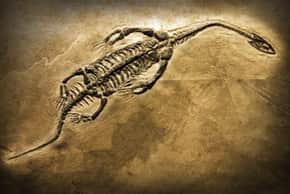LS4 Biological Evolution Lesson Plans

Evolution lesson plans designed for high school, middle school, and elementary school science teachers are downloadable here. The driving question for evolution is "What evidence shows that different species are related?" Click on the ngss units below to see a list of free lessons by standard.
-
High School LS4 Lesson Plans
HS-LS4.A: Evidence of Common Ancestry and Diversity
- HS-LS4-1 Lesson Plans: Communicate scientific information that common ancestry and biological evolution are supported by multiple lines of empirical evidence.
HS-LS4.B: Natural Selection
- HS-LS4-2 Lesson Plans: Construct an explanation based on evidence that the process of evolution primarily results from four factors: (1) the potential for a species to increase in number, (2) the heritable genetic variation of individuals in a species due to mutation and sexual reproduction, (3) competition for limited resources, and (4) the proliferation of those organisms that are better able to survive and reproduce in the environment.
- HS-LS4-3 Lesson Plans: Apply concepts of statistics and probability to support explanations that organisms with an advantageous heritable trait tend to increase in proportion to organisms lacking this trait.
HS-LS4.C: Adaptation
- HS-LS4-2 Lesson Plans: Construct an explanation based on evidence that the process of evolution primarily results from four factors: (1) the potential for a species to increase in number, (2) the heritable genetic variation of individuals in a species due to mutation and sexual reproduction, (3) competition for limited resources, and (4) the proliferation of those organisms that are better able to survive and reproduce in the environment.
- HS-LS4-3 Lesson Plans: Apply concepts of statistics and probability to support explanations that organisms with an advantageous heritable trait tend to increase in proportion to organisms lacking this trait.
- HS-LS4-4 Lesson Plans: Construct an explanation based on evidence for how natural selection leads to adaptation of populations.
- HS-LS4-5 Lesson Plans: Evaluate the evidence supporting claims that changes in environmental conditions may result in: (1) increases in the number of individuals of some species, (2) the emergence of new species over time, and (3) the extinction of other species.
HS-LS4.D: Biodiversity and Humans
- HS-LS4-6 Lesson Plans: Create or revise a simulation to test a solution to mitigate adverse impacts of human activity on biodiversity.
-
Middle School LS4 Lesson Plans
MS-LS4.A: Evidence of Common Ancestry and Diversity
- MS-LS4-1 Lesson Plans: Analyze and interpret data for patterns in the fossil record that document the existence, diversity, extinction, and change of life forms throughout the history of life on Earth under the assumption that natural laws operate today as in the past.
- MS-LS4-2 Lesson Plans: Apply scientific ideas to construct an explanation for the anatomical similarities and differences among modern organisms and between modern and fossil organisms to infer evolutionary relationships.
- MS-LS4-3 Lesson Plans: Analyze displays of pictorial data to compare patterns of similarities in the embryological development across multiple species to identify relationships not evident in the fully formed anatomy.
MS-LS4.B: Natural Selection
- MS-LS4-4 Lesson Plans: Construct an explanation based on evidence that describes how genetic variations of traits in a population increase some individuals’ probability of surviving and reproducing in a specific environment.
- MS-LS4-5 Lesson Plans: Gather and synthesize information about the technologies that have changed the way humans influence the inheritance of desired traits in organisms.
MS-LS4.C: Adaptation
- MS-LS4-6 Lesson Plans: Use mathematical representations to support explanations of how natural selection may lead to increases and decreases of specific traits in populations over time.
-
Elementary LS4 Lesson Plans
- 2-LS4-1 Lesson Plans: Make observations of plants and animals to compare the diversity of life in different habitats.
 Lesson Plans
Lesson Plans